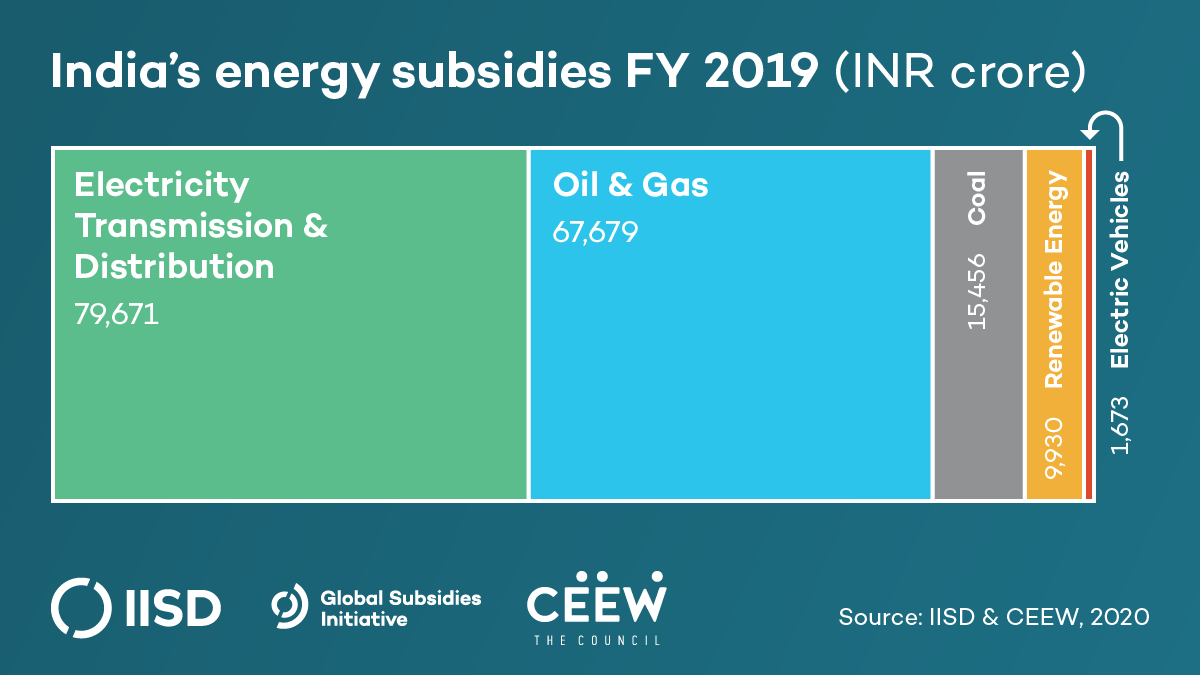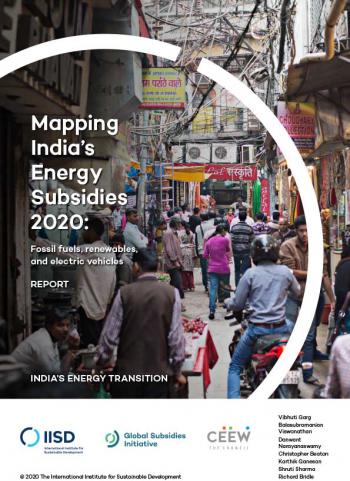Report
Mapping India’s Energy Subsidies 2020
Fossil Fuels, Renewables, Electric Vehicles
Vibhuti Garg, Balasubramanian Viswanathan, Danwant Narayanaswamy, Christopher Beaton, Karthik Ganesan, Richard Bridle
April 2020 | Energy Transitions, Power Markets
Suggested Citation: Garg, Vibhuti, Balasubramanian Viswanathan, Danwant Narayanaswamy, Christopher Beaton, Karthik Ganesan, Shruti Sharma and Richard Bridle. 2020. Mapping India's Energy Subsidies 2020 – Fossil fuels, renewables and electric vehicles. Winnipeg: International Institute for Sustainable Development.
Overview
This report, published in collaboration with IISD, examines how the Government of India (GoI) has used subsidies to support different types of energy and analyses crucial developments between FY 2014 and FY 2019. It examines how India’s energy subsidy policies changed, the most significant developments in the dynamic energy policy environment and whether public support aligned with India’s desired energy future. It also assesses how energy subsidies might change in response to the Covid-19 crisis. The subsidies have been categorised into five groups: coal; oil and gas (O&G); electricity transmission and distribution (T&D); renewable energy (RE); and electric vehicles (EVs). All categories include the full value chain of production and consumption.
The report is the latest update in a series of reviews of India’s energy subsidies - India’s Energy Transition 2017 and India’s Energy Transition, 2018 Update. Since this review was last conducted, India has declared its intention to conduct a peer review of its fossil fuel subsidies with France as part of the G20 commitment to phase out subsidies.
Key Findings
- As of 2018, primary commercial energy consumption comprised 56 per cent coal, 30 per cent oil, 6 per cent gas, 3 per cent renewables, 4 per cent hydro and 1 per cent nuclear.
- Since 2017, government support for fossil fuels increased by 65 per cent while support for renewables declined by 35 per cent.
- The general trend since FY 2014 is still a net shift of support away from fossil fuels and toward clean energy.
- However, India’s subsidies to oil, gas and coal (INR 83,134 crore in FY 2019) are seven times more than the value of subsidies to renewables and electric vehicles.
- Quantified coal subsidies have remained stable since FY 2014, declining only marginally from INR 15,660 crore to INR 15,456 crore in FY 2019.
- From FY 2017 to FY 2019, O&G subsidies increased by two thirds, largely due to higher oil prices and growing LPG use. However, subsidies in FY 2019 remain 57 per cent lower than FY 2014.
- All LPG policies together amount to INR 54,518 crore. It is 28 per cent of all energy subsidies and 64 per cent of all O&G subsidies.
- Subsidies to T&D have doubled between FY 2014 to FY 2019, from INR 41,252 crore to INR 79,671 crore.
- The largest T&D subsidy is under-pricing of electricity, worth INR 63,778 crore. It is 33 per cent of all energy subsidies and 80 per cent of all T&D subsidies.
- RE subsidies have increased three-fold between FY 2014 and FY 2019 - from INR 3,224 crore to INR 9,930 crore.
- In FY 2019, subsidies for EVs increased over 400 times to INR 1673 crore from INR 3.8 crore in FY 2014.

Source: Author's analysis
Key Recommendations
- Prioritise health and economic recovery while navigating the COVID-19 crisis—but clean energy transition can and should be reflected in coping strategies and support measures.
- Resist new O&G subsidies. Volatile prices make them a liability; they are hard to remove once introduced; and they cause fossil energy lock-in.
- Adopt RE subsidies for emerging technologies and grid balancing. Clean electricity is essential. Other sectors, such as transport and cooking, will rely on electrification to deliver clean energy.
- Target consumption subsidies for energy access - LPG and electricity - without harming energy access.
- Address the full costs of coal. A plan is needed to address coal pricing in a socially responsible way, including diversifying revenues and protecting consumers and workers.
- Monitor and adapt EV subsidies to ensure effective, efficient and equitable support, including for two-wheelers, public transport, waste treatment, and battery recycling.
- Develop formal reporting structures on subsidies in line with formal guidelines for SDG 12(c)1 and India’s G20 peer review of fossil fuel subsidies.
Government support for fossil fuels has increased by 65 per cent in the past two years while support for renewables declined by 35 per cent. The general trend since FY 2014, however, is still a net shift of support away from fossil fuels and toward clean energy.








